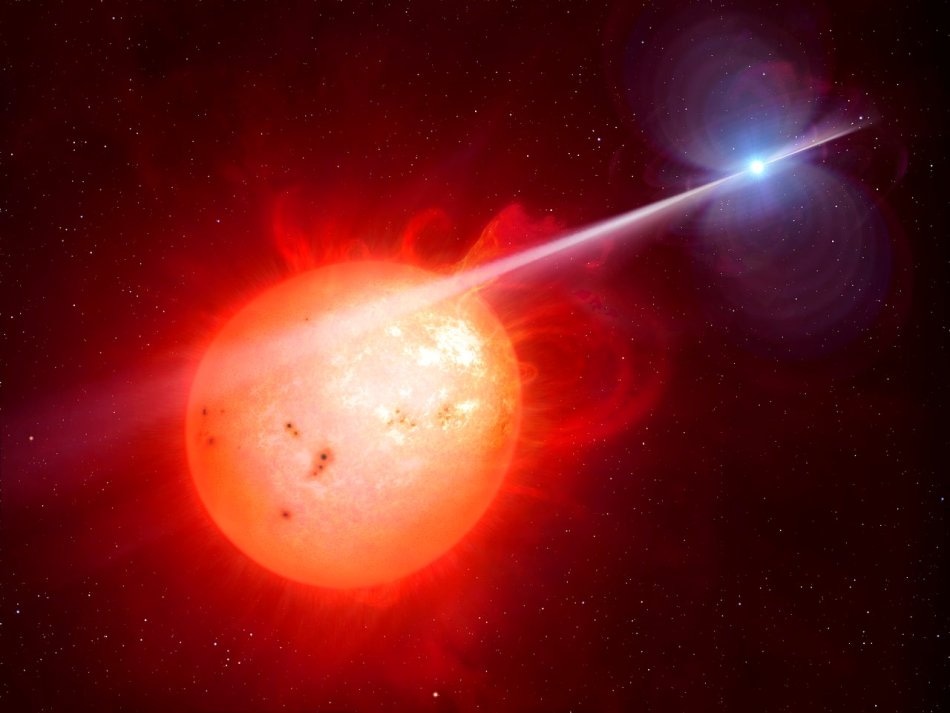Jul 28 2016
An exotic binary star has been discovered for the very first time by astronomers using the NASA/ESA Hubble Space Telescope with other telescopes both in space and on the ground.
 This artist's impression shows the strange object AR Scorpii. In this unique double star a rapidly spinning white dwarf star (right) powers electrons up to almost the speed of light. These high energy particles release blasts of radiation that lash the companion red dwarf star (left) and cause the entire system to pulse dramatically every 1.97 minutes with radiation ranging from the ultraviolet to radio. CREDIT: M. Garlick/University of Warwick, ESA/Hubble
This artist's impression shows the strange object AR Scorpii. In this unique double star a rapidly spinning white dwarf star (right) powers electrons up to almost the speed of light. These high energy particles release blasts of radiation that lash the companion red dwarf star (left) and cause the entire system to pulse dramatically every 1.97 minutes with radiation ranging from the ultraviolet to radio. CREDIT: M. Garlick/University of Warwick, ESA/Hubble
A white dwarf star in the system AR Scorpii is spinning extremely fast, powering electrons up to almost the speed at which light travels. Radiation is released from these high energy particles in blasts, which lash the companion red dwarf star, causing the entire system to pulse dramatically every 1.97 minutes, with a range of radiation from radio to ultraviolet.
In May 2015, amateur astronomers from the UK, Belgium, and Germany identified a star system displaying behavior that has never been encountered before. The real nature of this misidentified system was revealed by follow-up observations conducted by the University of Warwick, and using an increasing number of telescopes in space and on the ground, including the NASA/ESA Hubble Space Telescope.
The star system AR Scorpii (AR Sco) exists in the constellation of Scorpius, 380 light-years from Earth. It has a white dwarf that spins extremely fast and is the same size as Earth but comprises 200,000 times more mass. It also has a cool red dwarf companion one third the mass of the Sun. They orbit each other every 3.6 hours, in a cosmic dance as regular as clockwork.
The brutal behavior exhibited by this binary star system is considered to be a unique twist. With its rapid spinning and highly magnetic natures, the white dwarf increases the speed of the electrons almost equal to the speed of light. These high energy particles travel through space and discharge radiation in a lighthouse-like beam, which whips across the cool red dwarf star’s face.
This results the whole system brightening and fading in a dramatic manner every 1.97 minutes. These powerful pulses contain radiation at radio frequencies, which have never before been identified in a white dwarf system.
AR Scorpii was discovered over 40 years ago, but its true nature was not suspected until we started observing it in June 2015. We realized we were seeing something extraordinary the more we progressed with our observations.
Tom Marsh, Lead Researcher, University of Warwick
Properties identified in the AR Sco are mysterious and unique. The radiation across a wide range of frequencies proves to be indicative of emission from electrons accelerated in magnetic fields, which can be described by AR Sco’s spinning white dwarf. Another mysterious fact refers to the source of the electrons themselves as it is still not clear whether it is linked to its cooler companion, or the white dwarf.
It was in the early 1970s that the occurrence of AR Scorpii was first detected. The normal fluctuations in brightness every 3.6 hours resulted in incorrectly classifying AR Scorpii as a lone variable star. The collaborative efforts of professional and amateur astronomers helped reveal the source of AR Scorpii’s varying luminosity. Previously, a similar pulsing behavior was observed from neutron stars and not from white dwarfs. Neutron stars are known to be some of the densest celestial objects to be found in the Universe.
We've known about pulsing neutron stars for nearly fifty years, and some theories predicted white dwarfs could show similar behavior. It's very exciting that we have discovered such a system, and it has been a fantastic example of amateur astronomers and academics working together.
Boris Gänsicke, University of Warwick